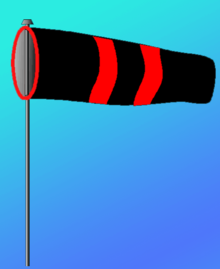Clicker
The clicker is a wind indicator on a sailing boat . It indicates the direction of the apparent wind .
The name is already documented for the 19th century and probably comes from the seaman's language . Originally it only referred to the pennants , flags or (club) stands attached to the top of the mast , which seafarers and hobby sailors "clicked" on the direction of the wind on board, that is, made it clear. Today, more technically complex wind indicators in a different design are often called clickers.
Purpose and requirements
When sailing, clickers are primarily used to observe the course to the wind and changes in the angle of incidence of the wind. They are mainly needed to optimize the sail trim and boat course.
Clickers are not suitable for recording or even measuring the actual wind conditions in the area: If a boat is in motion, every wind direction indicator on board no longer shows the true , meteorological wind. This could only be determined from a stationary location. Instead, it shows the apparent or on-board wind , which results from the (vectorial) sum of true wind and headwind. In order to infer the direction of the true wind from the position of a clicker, one's own movement relative to the earth's surface must be taken into account.
If you want to use an instrument on board to determine the wind, the effects of the air flow around the sails and the vehicle create special problems that must at least be taken into account by choosing a suitable location. Clickers are therefore preferably installed in or near the masthead : there they are least affected by the air flow around the sails, have room to move and can be viewed from the cockpit at almost any time. In the harbor, this location also offers (relative) protection from the rigs of neighboring boats moving in the swell . However, the position at the top of the mast also has disadvantages. In rough seas, the ship movements transmitted by the mast have a particularly drastic effect, which must be taken into account when interpreting the clicker deflections.
The requirement for the mechanical properties of clickers is that, on the one hand, changes in wind direction in gusts should be recognized quickly (responsiveness), and on the other hand, not every slight change in the heel of the boat should immediately lead to a reversal of the indicator (movement dampening). In addition, clickers should remain easily recognizable even when facing the sun and also be easy to read when driving at night. After all, due to their low weight, they should only increase the load in the mast top insignificantly, be safe to mount and not hinder the function of the other marine equipment installed there (mast fittings, drop rollers , antennas, position lights ).
Designs
Clickers are available in different designs and designs:
- Rotatable , now predominantly square and signal-colored stands (wind flags) made of plastic or canvas, which are usually reinforced with a wire frame, are common on dinghies .
- Arrow-shaped wind direction indicators made of plastic or stainless steel are often used on yachts. After the most famous branded product, wind direction indicators of this type are generally referred to as "Windex" . In a high-quality design, yacht clickers are very light and easy to move, can be balanced with an adjustable weight and, thanks to reflective foils at the tip and stern, can also be read at night. They usually include an adjustable, but otherwise fixed pair of arms (reference pointer) for easier estimation of the course to the wind.
- Shroud clickers , rotatable wind flags or arrows that are attached to a wire bracket in the shrouds, are more of a “makeshift” . They are always required in pairs, on the port and starboard shrouds. On Luvwant show position due to a need of interpretation mixture of apparent wind and current conditions on the mainsail, on the leeward shroud they are often hidden by the sail.
More wind indicators and meters while sailing
- Trim or telltales are on both sides (and sometimes also to the sail in the or its leech secured wool threads or plastic strips shrouds to find). They represent the simplest way to visualize the flow of the wind on the surface of the sails. They allow a very precise sail trim .
- Windbüdel are wind indicators on mostly larger traditional ships . They are funnel-shaped windsocks , as they are also known from motorway bridges or airports. Not only can they show the direction of the apparent wind while sailing, but they also provide clues as to its strength. They are also as Flögel known well in line with the Dutch Vleugel (Wing), elongated wind indicator on flat-bottomed boats with a Flögelholz as " headboard " whose color informs also about the purpose of the ship.
- Electronic measuring devices for wind determination are increasingly being used on sport and leisure boats. The wind direction is determined by electronic wind direction transmitters (direction sensors on conventional wind arrows or flags), the wind strength by a wing or cup cross anemometer . The measurement results transmitted by wire or radio are evaluated electronically and shown on displays on the mast, in the cockpit or on a subsidiary display at the navigation station. With some construction types, they can be processed or recorded ( logged ) by other nautical devices . Together with other information (e.g. about the ship's journey), on-board computers can also approximately calculate the amount and direction of the true wind.






